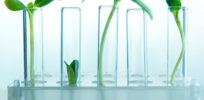Earlham Institute

Moth sex pheromones: Tweaking plants with gene editing can replace some pesticides
By using precision gene engineering techniques, researchers at the Earlham Institute in Norwich have been able to turn tobacco plants ...

Plants have circadian clocks; knowing how they ‘tick’ could optimize crops for diverse growing conditions
It's widely understood that humans have a circadian clock. When we travel long distances, things get knocked out of kilter ...

Newly discovered ‘gene conversion’ mechanism could lead to high-yielding wheat
When it comes to breeding better wheat varieties....we seek to introduce desirable genes that increase yield, [but] these can come ...

Cell free proteins? Unraveling the mysteries of the plant circadian clock
The basic unit of life is the cell; tiny, fatty, self-replicating bubbles that have adapted to fill almost every environment ...

New sequencing technique will make cloning genes for disease resistance in plants easier
[The] constant evolutionary arms race between plants and pathogens, whereby the organisms causing disease in plants are mutating to avoid plant ...

